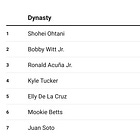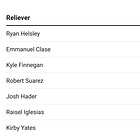Fantasy Baseball Dynasty Top 700 Rankings & Trade Value Version 2.15
This week: an impact veteran hitter, plus a pair of young hitters off to strong starts.
New this week: a look at a veteran outfielder enjoying a strong bounce-back season who could see even more production moving forward.
Plus, two young hitters who are enjoying strong starts that, while promising in terms of some metrics, might not be the most sustainable long-term. One is a definite trade candidate (to trade away) if you can find a trade that brings back a relatively strong return.
(A quick note, if you’re having trouble reading the table in full in the Substack app, it can be viewed in full either in the email or in a web browser.)
If you have any questions about trade offers, the waiver wire, last minute start/sit options, roster construction strategies, or anything specific to your fantasy team, becoming a paid subscriber grants you access to my daily fantasy help chat where I’ll be answering all of your fantasy baseball questions every weekday, whether it’s redraft or dynasty, or during the offseason, draft season, the regular season or the fantasy playoffs. The main goal of this Substack? To help you win your fantasy leagues.
Christian Yelich (#57, 64 trade value).
Coming off a productive, yet injury-shortened season in 2024, the 33-year-old Yelich got off to a slow start in 2025.
Some may have questioned if this was the beginning of his fantasy ceiling starting to taper off.
The veteran outfielder hit just .154 with a .279 on-base percentage, three home runs and three stolen bases through his first 61 plate appearances in 2025, sporting just a 5.6% barrel rate in the process.
And while Yelich’s hard-hit rate was 55.6% during that time, it certainly wasn’t an encouraging start.
Fast forward to now, though, and the slow start is already very much a thing of the past. Yelich is batting .327 with a .414 on-base percentage, two home runs and three stolen bases since April 13, continuing to hit in the top third of the Milwaukee Brewers lineup and providing the National League Central club and fantasy managers with above-average production.
The veteran actually is sporting a 5.1% barrel rate and a 43.6% hard-hit rate during that span.
Really, Yelich was never going to hit under .160 for an extended period, and while his barrel rate has dropped off slightly (we are still only in April), his underlying and quality of contact metrics look fairly similar to the numbers he posted in 2024 when he hit .315 with a .406 on-base percentage, 11 home runs and 21 stolen baes in 315 plate appearances.
Christian Yelich in 2024: .373 xwOBA, .416 xwOBAcon, 46.7% hard-hit rate, 18.4 K%, 12.7 BB%, 7.9% barrel rate, 54.2% ground ball rate
Christian Yelich in 2025: .352 xwOBA, .406 xwOBAcon, 50.7% hard-hit rate, 22.7 K%, 13.4 BB%, 5.3% barrel rate, 62.7% ground ball rate.
Something else to watch? The ground ball and line drive rates.
I wrote about using line drive rates (or low line drive rates) to find bounce-back candidates last week, and that certainly applies here with Yelich. The veteran outfielder has always logged fairly consistent line drive rate numbers, albeit with higher ground ball rates.
Using Line Drive Rate To Find Bounce-Back and Breakout Candidates
Line drives are, generally speaking, statistically a preferable outcome.
At any rate, his production should stand to benefit even more so once that line drive rate improves.
Christian Yelich In Seasons With 300+ Plate Appearances Since 2015:
2016: 58.4 GB%, 28.1 LD%
2017: 55.6 GB%, 25.5 LD%
2018: 52.8 GB%, 27.4 LD%
2019: 42.8 GB%, 24.1 LD%
2020: 51.6 GB%, 23.4 LD%
2021: 55.7 GB%, 23.9 LD%
2022: 59.1 GB%, 19.7 LD%
2023: 57.4 GB%, 22.4 LD%
2024: 54.2 GB%, 23.4 LD%
2025: 62.7 GB%, 18.7 LD%
Andy Pages (#344, 30 trade value).
Now might be the time to trade away Andy Pages in dynasty. Or at least consider it if you can get a strong return and are set from an outfield depth and options standpoint now and later.
The 24-year-old is off to a strong start this season, batting .276 with a .357 on-base percentage, a .494 slugging percentage, five home runs and a pair of stolen bases in 98 plate appearances for the National League West franchise. His wOBA sits at .375 and his wRC+ sits at 140.
However, while Pages has shown good bat speed (72.8 MPH) and logged a solid whiff rate (21.5), his underlying metrics suggest some serious statistical regression coming.
Pages’ xwOBA sits at just .308 and his xwOBAcon is currently just .365. His hard-hit rate has dropped from 40.1% last season to 30.2% this season.
For reference, 52 batters had an xwOBA of .365 or less last season.
Of those 52 batters, 35 had an OPS under .737. Of those 52 batters, 23 had an OPS below league average (.711 in 2024).
And while it’s a reasonably small sample size this year, Pages was just over the league average OPS last year with a .712 OPS in 443 plate appearances.
Maybe in a different lineup, it’s a different story for a 24-year-old outfielder who has flashed upside at times, but the Dodgers are flush with outfield depth. Michael Conforto, Teoscar Hernandez, Enrique Hernandez, Chris Taylor, Tommy Edman and Mookie Betts can all play the outfield among the team’s options on the Major League roster.
Top prospects Hyeseong Kim and Dalton Rushing have seen time in the outfield at Triple-A (and both have been extremely productive at the minors’ highest level this season), with James Outman and Estuery Ruiz also on hand at Triple-A.
Los Angeles is also in a good spot long-term with highly promising outfielders Zyhir Hope, Josue De Paula and Eduardo Quintero in the lower minors.
There’s also the fact that the club is constantly active in trades and free agency in adding Major League upgrades.
Add it all up, and it’s hard to see Pages having a consistent (keyword) long-term role with the Dodgers, even if his early 2025 production wasn’t a cause for statistical regression.
If you’re in a good spot with outfielders on your roster, or are even rebuilding, now might be the time to see what you can get. Don’t just trade him to trade him, but if the return is good, now might be the time to make a move.
Noelvi Marte (#312, 32 trade value).
The good news: Noelvi Marte is playing in a regular role with the Cincinnati Reds and is thriving at the plate.
The infielder entered play Thursday hitting .370 with a .431 on-base percentage, three home runs and four stolen bases in 51 plate appearances, sporting a .373 xwOBA, a 202 wRC+ and just an 11.8% strikeout rate so far. His average bat speed (74.2 MPH) is promising, too.
That’s all good. If he’s on your team, he’s likely made an immediate impact. If he’s on the waiver wire because some dynasty managers dropped him following last season’s 80-game suspension for testing positive for a performance-enhancing substance. It also probably wasn’t ideal that Marte hit .210 with a .248 on-base percentage, a 46 wRC+ and a 31.0% strikeout rate in 242 Major League plate appearances.
If he’s still available via waivers in your league, now’s the time to add him. There’s enough intrigue and upside with Marte’s power and speed production in one of the league’s most hitter-friendly ballparks.
And while there are plenty of encouraging numbers in Marte’s stats, maybe expect more good production than great production moving forward.
Because it’s very much worth wondering how sustainable the elite production is. If Marte’s quality of contact numbers continues, the surface-level production might drop off a bit.
The expected batting average (.277) and expected slugging (.522) are both solid numbers, but the 23-year-old’s xwOBA is benefiting from just an 11.8% strikeout rate. Marte’s xwOBAcon sits at .388, which is good, but not great in the way the infielder’s xwOBA is. His barrel rate sits at just 7.5% so far, with a 30.0% hard-hit rate.
In short, he’s worth a look in the short term. If the surface-level numbers continue to be good and the underlying metrics continue to be unideal in places, it might not be the worst time to see what you can get for him in a trade. But that’s another story for another day.
Beware the Open Roster Spot (Or lack thereof)
Oh and one more quick note, beware the open roster spot, or lack thereof rather, in trades.
While a two-for-one or even a three-for-one or four-for-two deal might line up from a trade value standpoint, the roster spots are worth considering. Essentially, if you’re having to cut someone, it turns into you giving up another player or players in addition to potentially the best player in the deal. It’s obviously a different story if you’re working with a flexible roster or open roster spots, but it adds another layer to deals that can potentially change the calculus of things considerably.
Also a quick note on prospects:
Proximity matters. Upside is obviously king here, but proximity to the Majors matters here as well with prospects, at least from a fantasy standpoint. It can be a bit of a tie-breaker with prospects with similar upside but at different minor league levels. Furthermore, the farther away a prospect is from the Majors, the more it impacts their fantasy trade value.
Of course, that’s not going to have much of a difference with elite prospects in the low minors like Ethan Salas or Max Clark, but it’s why some prospects who aren’t necessarily in the upper echelon of fantasy prospects, may have a lower trade value number in dynasty formats than a lower ceiling player already in the Majors who is guaranteed to provide MLB (and fantasy) production at least in the coming years.
Last week’s rankings and analysis:
New Weekly Column Alert! (Check out Week 1’s column for free!) Really excited about this!
League Winners Week 1: Three Potential (Future) Aces
Welcome to League Winners! A new weekly, in-season column that I’m really excited to debut.







